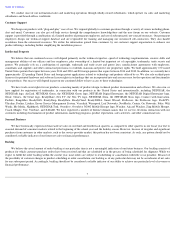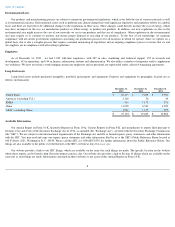Netgear 2013 Annual Report Download - page 20
Download and view the complete annual report
Please find page 20 of the 2013 Netgear annual report below. You can navigate through the pages in the report by either clicking on the pages listed below, or by using the keyword search tool below to find specific information within the annual report.
Table of Contents
Further, our revenue may be impacted by significant one-
time purchases which are not contemplated to be repeatable. While such purchases are
reflected in our financial statements, we do not rely on and do not forecast for continued significant one-
time purchases. As a result, lack of repeatable
one-time purchases will adversely affect our revenue.
Because our expenses are based on our revenue forecasts, a substantial reduction or delay in sales of our products to, or unexpected returns from,
customers and resellers, or the loss of any significant customer or reseller, could harm or otherwise have a negative impact to our operating results.
Although our largest customers may vary from period to period, we anticipate that our operating results for any given period will continue to depend on
large orders from a small number of customers.
If we do not effectively manage our sales channel inventory and product mix, we may incur costs associated with excess inventory, or lose sales
from having too few products.
If we are unable to properly monitor, control and manage our sales channel inventory and maintain an appropriate level and mix of products with
our wholesale distributors and within our sales channels, we may incur increased and unexpected costs associated with this inventory. We generally
allow wholesale distributors and traditional retailers to return a limited amount of our products in exchange for other products. Under our price
protection policy, if we reduce the list price of a product, we are often required to issue a credit in an amount equal to the reduction for each of the
products held in inventory by our wholesale distributors and retailers. If our wholesale distributors and retailers are unable to sell their inventory in a
timely manner, we might lower the price of the products, or these parties may exchange the products for newer products. Also, during the transition from
an existing product to a new replacement product, we must accurately predict the demand for the existing and the new product. For example, in the first
quarter of 2013, while transitioning from our existing ReadyNAS product line to our new line of ReadyNAS products, we were not able to execute on
the launch of the new product. This led to our inability to have sufficient quantities of the existing line of ReadyNAS products as we had ramped down
supply anticipating the transition, which adversely affected our profitability for the quarter.
We determine production levels based on our forecasts of demand for our products. Actual demand for our products depends on many factors,
which makes it difficult to forecast. We have experienced differences between our actual and our forecasted demand in the past and expect differences to
arise in the future. If we improperly forecast demand for our products we could end up with too many products and be unable to sell the excess inventory
in a timely manner, if at all, or, alternatively we could end up with too few products and not be able to satisfy demand. This problem is exacerbated
because we attempt to closely match inventory levels with product demand leaving limited margin for error. If these events occur, we could incur
increased expenses associated with writing off excessive or obsolete inventory, lose sales, incur penalties for late delivery or have to ship products by air
freight to meet immediate demand incurring incremental freight costs above the sea freight costs, a preferred method, and suffering a corresponding
decline in gross margins.
Our business is subject to the risks of international operations.
We derive a significant portion of our revenue from international operations. As a result, our financial condition and operating results could be
significantly affected by risks associated with international activities, including economic and labor conditions, political instability, tax laws, changes in
the value of the U.S. dollar versus local currencies, and natural disasters. Margins on sales of our products in foreign countries, and on sales of products
that include components obtained from foreign suppliers, could be materially adversely affected by foreign currency exchange rate fluctuations and by
international trade regulations. Additionally, certain foreign countries have complex regulatory requirements as conditions of doing business. For
example, the United Kingdom Anti-
Bribery Act of 2010 is broad legislation that prohibits bribery and applies to our operations worldwide. This foreign
legislation follows in the spirit of the U.S. Foreign Corrupt Practices Act and focuses additional governmental efforts on anticorruption efforts
worldwide. Meeting these requirements may increase our operating expenses as we continue to expand internationally.
We obtain several key components from limited or sole sources, and if these sources fail to satisfy our supply requirements or we are unable to
properly manage our supply requirements with our third party manufacturers, we may lose sales and experience increased component costs.
Any shortage or delay in the supply of key product components would harm our ability to meet scheduled product deliveries. Many of the
semiconductors used in our products are specifically designed for use in our products and are obtained from sole
17
•
our reseller agreements generally do not require substantial minimum purchases;
•
our customers can stop purchasing and our resellers can stop marketing our products at any time; and
•
our reseller agreements generally are not exclusive.
























